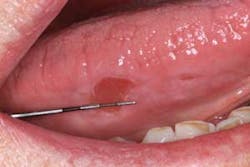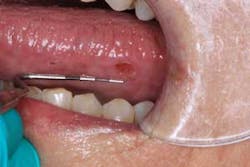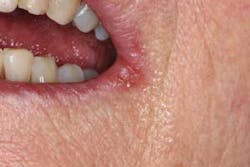This article first appeared in the newsletter, DE's Breakthrough Clinical with Stacey Simmons, DDS. Subscribe here.
A 64-year-old female presents for her scaling and root planing (SRP) appointment. Prior to commencing with care, she expressed concern over some lesions in her mouth that had developed over the course of the last few weeks after her last SRP appointment—sores that had only progressively gotten bigger. She stated that eating and drinking were difficult.
Clinical assessment revealed overall red, inflamed tissue throughout the oral cavity. Most notably present were large, ulcer-like lesions on the right and left lateral borders of the tongue (figures 1 and 2). The edges were well defined; the red center slightly concave and very tender to palpation. Further, the vestibular tissue, upon the slightest touch, sloughed and hemorrhaged easily. Angular cheilitis was observed, and opening was painful (figure 3).
To better understand, here is the patient’s history: Prior to her recare appointment, which was 1.5 months ago, it had been almost two years since she had been seen. During this hiatus, she had a heart attack and stroke. She has a history of hepatitis C, for which she has been on the liver transplant list. Her list of medications include furosemide (blood pressure/diuretic), escitalopram (depression), ursodiol (gallstones), omeprazole (GERD, heartburn), baclofen (muscle relaxant), spironolactone (blood pressure, diuretic), bupropion (depression), potassium (urinary), trazodone (depression), gabapentin (antseizure), lactulose (laxative), and estradiol (hormone). Just three weeks prior to this scaling and root planing, she began the medication Harvoni, a drug used to treat chronic hepatitis C.
With this presentation and history, what are your recommended treatment modalities and differentials?
MORE PATHOLOGY CASES . . .This article first appeared in the newsletter, DE's Breakthrough Clinical with Stacey Simmons, DDS. Subscribe here.
Do you have an interesting oral pathology case you would like to share with Breakthrough’s readers? If so, submit a clinical radiograph or high-resolution photograph, a patient history, diagnosis, and treatment rendered to: [email protected]. We will let you know if we select your case!










